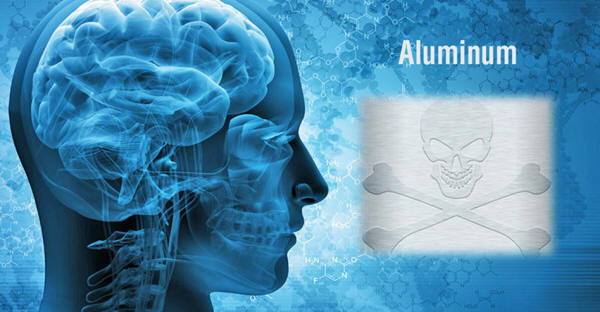|
Scientists have been aware of aluminum's neurotoxicity for decades.
Although aluminum's apologists have tried to shroud the metal's risks in manufactured controversy, a growing number of reports by researchers in the,
...and elsewhere has furnished substantive evidence linking aluminum to neuropathology, including the epidemics of, Aluminum levels were particularly high in the male brains, including in a 15-year-old boy with ASD who had the study's single highest brain aluminum measurement.
Dr. Christopher Exley - one of the world's leading experts on aluminum toxicity - has shown that chronic intoxication with myriad forms of this,
Dr. Exley and other aluminum experts such as molecular biologist Dr. Lucija Tomljenovic have confirmed that aluminum readily and actively traverses the blood-brain barrier to selectively accumulate in brain tissues, where it induces unwelcome changes in brain biochemistry.
As Dr. Exley has noted,
Below is a video of him speaking on his study:
Documenting Aluminum in the ASD Brain
In light of the fact that even minute amounts of aluminum can have adverse neurological consequences, Dr. Exley's newest paper 'Aluminium in Brain Tissue in Autism' - which reports on the first-ever study of aluminum in ASD brain tissue - is groundbreaking.
Published in the Journal of Trace Elements in Medicine and Biology, the paper documents some of the highest values for aluminum in human brain tissue ever recorded.
Using a two-pronged study design, the researchers measured and characterized aluminum deposits in brain tissues from five to ten ASD donors, most of whom died in their teens or twenties:
What the research team found was startling.
The study's quantitative arm documented "consistently high" aluminum levels representing,
Specifically:
The study's qualitative findings were equally concerning:
The Importance of Glial Cells
There are three broad categories of non-neuronal (glial) cells, including,
In discussing their results, Dr. Exley's team comments that the intracellular location of most of the aluminum in these non-neuronal cells was the "standout observation" for ASD:
Unlike other brain cells, the microglia (which represent about 10% of brain cells) are dedicated immune cells.
Microglia also play a key role in the process known as synaptic pruning that takes place during vital phases of cognitive development in early childhood as well as adolescence, continuing into the late 20s.
This process, which some observers have likened to "neural spring cleaning," allows the maturing brain to shed "weak or redundant (neuronal) connections."
Given this and other important microglial functions, the microglia have attracted considerable research attention as key players in brain disease, including autism. (Astrocytes also have implications for autism, given the role of astrocyte dysfunction in seizures - a condition that is frequently comorbid with ASD.)
A pivotal review article (Microglia Emerge as Central Players in Brain Disease) published in 2017 observes that,
Evidence suggesting that the microglia are dysfunctional in ASD includes findings from postmortem ASD brain studies showing,
It is clear to many researchers that environmental factors can alter microglia function, negatively affecting brain development and synaptic connectivity.
When this occurs during important developmental periods, there may be "consequences throughout life."
Aluminum exposure undoubtedly constitutes a dangerous environmental exposure, and Dr. Exley observes that,
The Most Pervasive Exposure to Aluminum
The study's results strongly suggest that aluminum is entering the brain in ASD via cells that have become loaded up with aluminum in the periphery.
Where is the aluminum coming from?
One of the most pervasive routes of modern-day exposure to neurotoxic aluminum is via aluminum adjuvants in vaccines. (Vaccine manufacturers use aluminum adjuvants to intensify the vaccine recipient's immune response.)
Elsewhere, Dr. Exley has described the "migratory capabilities" of aluminum-based adjuvants "at sites distant to the injection site," including the brain.
The extreme levels of aluminum found in the brains of the study's teenage donors have alarming implications for the entire generation of highly aluminum-vaccinated children.
In the ASD brain paper, Dr. Exley and coauthors point out that the "burgeoning" use of aluminum-adjuvant-containing childhood vaccines,
A 2011 study by Lucija Tomljenovic and Christopher Shaw confirms that aluminum-containing vaccines are having crippling neurological consequences.
Their analysis (Do Aluminum Vaccine Adjuvants contribute to the Rising Prevalence of Autism?) shows that children from countries where ASD prevalence is highest have the highest exposure to aluminum from vaccines.
Moreover, children's increased exposure to aluminum adjuvants over the two decades starting in the 1990s significantly correlates with the increase in ASD prevalence in the U.S.
Counting the shots now pushed during pregnancy, highly vaccinated American children may receive up to 73 total vaccine doses by age 18, including multiple rounds of injected aluminum.
U.S. vaccines containing one or more aluminum adjuvants *
* Aluminum hydroxide, aluminum phosphate, aluminum salts, amorphous aluminum hydroxyphosphate sulfate (AAHS), potassium aluminum sulfate
Crucially, Dr. Exley and coauthors note that what,
The extreme levels of aluminum found in the brains of the study's teenage donors have alarming implications for the entire generation of highly aluminum-vaccinated children.
Moreover, Dr. Exley's other research has consistently shown that aluminum is the most significant contributing factor to Alzheimer's disease.
Given that it is no longer unheard of to see Alzheimer's being diagnosed in people who are in their 20s, 30s, or 40s, it is not unreasonable to worry that a catastrophic new wave of AD may be about to compound children's already heavy burden of ASD and other neurological disorders.
Recognizing the risks, numerous researchers have called for a halt to the use of aluminum salts in vaccines.
The powerful results of this study underscore the urgency of heeding this plea as well as eliminating exposure to other sources of neurotoxic aluminum.
|


